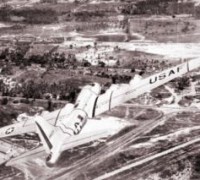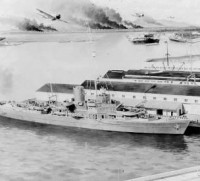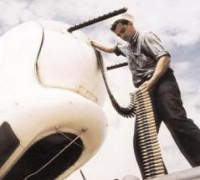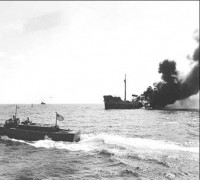BRAZIL. THE HARD ROAD TO WAR * - THE HARD ROAD TO WAR
2)BRAZIL THEATER PLANNING
Before and during the ARCADIA Conference, Army opinion was unanimous that the principal Brazilian air bases must be defended by American combat forces just as soon as possible. In mid-December this project had a priority immediately below that of reinforcing the continental United States, Hawaii, and the Panama Canal Zone.The Army Air Forces was about to launch its Project X--the planned movement of eighty heavy bombers to the Far East, initiated by orders of 19 December.
With this movement in prospect, Secretary Stimson termed the protection of the airway "a very emergent problem," and the War Plans Division held that the "occupation of Natal by American forces in considerable strength affords the only reasonable assurance that we can maintain communications in the South Atlantic and a base from which long-range airplanes can fly to Africa and thence to the Middle East and the Far East.
"General Marshall believed that at the very minimum the Army ought to place a reinforced and specially equipped 1,200-man infantry battalion, supported by seven or eight combat airplanes, at each of the three key air bases in Brazil. The United States Army thought it might have to do much more if German forces moved into Spain and Africa, and this appeared a likely development as the ARCADIA meetings began.
In their joint estimate of 20 December General Marshall and Admiral Stark expressed the belief that "Germany's failure to achieve full success in Russia may strongly influence her to invade Spain, Portugal and French North and West Africa for the purpose of restoring the balance." Two days later, at the initial meeting between the President, the Prime Minister, and their political advisers, "there was general agreement that if Hitler was held in Russia he must try something else, and that the most probable line was Spain and Portugal en route to North Africa."
The Army therefore had good reason to believe that it might be called upon to send an expeditionary force to Northeast Brazil in the very near future. Despite their apprehensions, General Marshall and the Army planners did not want to move either a small or a large force to the Brazilian bulge without Brazil's full consent and cooperation. The Army had hoped that the arrival of the Marine companies would provide the opening wedge to overcome the continued opposition of the Brazilian Army and Air Force to the entry of American combat forces.
On 20 December Under Secretary of State Welles assured General Marshall that Brazilian military as well as civilian sentiment toward collaboration in defense was "rapidly improving," and that "he thought Brazilian agreement to the rapid reinforcement we think necessary might be secured within ten days."
The War Plans Division thereupon advised the Chief of Staff: If the ten-day estimate is even approximately accurate, we can afford to wait, but no longer. Every week now adds to the peril and difficulty of sea-borne troop movements to that area. Axis submarines in numbers are now reported between Natal and the African coast. Known Axis capabilities, possible Brazilian internal reactions, and unpredictable surprise moves, combine to create a growing peril.
We now fight facing westward. The southeast lies open. Because the Department of State up to then had made no perceptible headway in persuading the Brazilian Government to consent to the establishment of Army defense forces in Brazil, the planners urged "that the Secretary of War suggest directly to the President the immediate dispatch of a special emissary, high in his confidence, and of high rank, with instructions to present the foregoing views to President Vargas in person, as an expression of the President's own opinion."
Acting on this recommendation, Secretary of War Stimson and General Marshall tentatively arranged for Vice President Wallace to fly to Brazil as spokesman for the Brazil project. They discussed the plan for a special emissary with President Roosevelt on 22 and 23 December, and the President's initial reaction was favorable. Mr. Wallace "volunteered" his services on the morning of 23 December; that afternoon he was thoroughly briefed on the Army's Brazil plans by Colonel Ridgway of the War Plans Division, and on the following day the Secretary of War approved the detailed arrangements for Mr. Wallace's trip.
Nevertheless, the Vice President did not go to Brazil, presumably because the President was persuaded by Under Secretary Welles that this special mission would compromise his position at the foreign ministers' meeting scheduled to assemble at Rio de Janeiro on 15 January.
Although President Roosevelt decided against sending a special emissary to Brazil, he was fully aware of the vital significance of the South Atlantic airway and of the dangers inherent in the Brazilian situation. He discussed the problem at some length in the first formal ARCADIA meeting on 23 December, at which it was also decided that the United States should have exclusive responsibility for planning and executing the Brazil operation.
In the meeting of 4 January, the President again "went into detail about why President Vargas of Brazil could not leap into action and give us permission to put more troops on the Natal Peninsula." President Vargas, Mr. Roosevelt remarked, "had to feel his way-be sure of his ground." The President announced that the Army and Navy must be prepared for action in Brazil, but that no decision to act could yet be made.
The Army's plan for action in Brazil contemplated the establishment of a Brazil theater with an ultimate Army strength of between 50,000 and 60,000 troops, or such smaller combat force, down to General Marshall's minimum of 3,600 men with air support, as the Brazilians might willingly admit to their territory. It will be recalled that General Headquarters had substantially completed an Operations Plan for a Northeast Brazil Theater on the eve of Pearl Harbor. The War Plans Division approved this plan on 17 December and designated the 9th Division as the principal component of the initial force.
The 45th Division was to be sent as reinforcement, if that became necessary. General Headquarters was directed to organize a task force for Brazil and, at General Headquarters' suggestion, General Marshall designated Maj. Gen. George Grunert, Commanding General, VI Army Corps, with headquarters at Providence, Rhode Island, as commander of the Brazil expedition.
General Grunert was the first task force commander to reach Washington after Pearl Harbor. He and members of his. VI Corps staff, and Brig. Gen. Rene E. deR. Hoyle, Commanding General, 9th Division, with members of his staff, reported to General Headquarters on the morning of 24 December to study and revise the Brazil theater plan.
The generals and their staffs, members of the General Headquarters staff, and members of the joint Planning Group that had visited Brazil the preceding summer worked together on the Brazil plan for six days. Thereafter, General Grunert and his staff continued to develop the plan--now designated LILAC--at their Providence headquarters.
The LILAC plan, like the Brazil plans drafted before Pearl Harbor, proposed the concentration of United States Army forces around the Belém, Natal, and Recife air bases, with the greatest strength at Natal. It provided for an initial ground force of about 15,000 men (the reinforced 9th Division less detachments) with air support, and for two reinforcing echelons, as needed, of 19,000 men each.
Considering the shortage of shipping and the urgent demands of other theaters, the Army probably could not have sent more than 15,000 ground troops to Brazil until much later in 1942. Despite the planning for a larger movement, the dispatch of a 15,000-man force, with adequate air support, would probably have ended the Army's apprehensions about the situation in Northeast Brazil and in the South Atlantic.
The Army's preparations for sending a task force to Brazil coincided with the establishment of a new Brazilian-American military board to coordinate defense arrangements in Northeast Brazil. The War Department in October 1941 had readily agreed to Brazil's proposal that a permanent joint military board be established to plan and supervise the construction of new base facilities, and by early November the United States and Brazilian Armies had informally arranged the details of the board's organization and duties. They agreed that its specific mission should be to "select the actual site of each installation, determine its cost, and recommend the share each country should bear of that cost."
This last element promised difficulties, since the division of costs would depend on what forces each nation contributed to the joint defense. After some delay General Miller, as Chief of the Military Mission, and General Dutra, the Brazilian Minister of War, signed an agreement on 17 December 1941 creating the joint Military Board for the Northeast.It provided that, in addition to a Brazilian general officer as president, the board was to have six members, with each nation contributing engineer, air, and naval officers.
The board was to be located permanently in Northeast Brazil after preliminary meetings in Rio de Janeiro. The Army selected Col. Robert C. Candee of the Air Corps and Col. Lucius D. Clay of the Corps of Engineers as its members of the new board and brought them into General Headquarters to study the Army's Brazil plans.
Like the members of the joint Planning Group, they were given a dual mission: in addition to doing the prescribed joint planning, they were to be General Grunert's and General Headquarters' advance agents in Brazil, since General Headquarters anticipated that they would eventually serve on the theater staff. The Army members of the board left Washington on 2 January 1942 and reached Rio de Janeiro five days later. Formal meetings of the new board began on 14 January, and nine days later Colonels Candee and Clay recommended the expenditure of $2,700,000 for airway improvements essential to the Ferrying Command's operations.
In addition, they urgently recommended that small groups of United States Army mechanics and communications specialists be put at each airfield and that emergency shipments of ammunition and machine guns be sent to Northeast Brazil to permit transient air crews and Brazilian Army troops to defend the fields and planes against any locally organized fifth-column attack.
The Joint Military Board was not able to take any effective action on these or any other proposals until the outcome of the Rio de Janeiro Foreign Ministers Conference was known and the separate discussions in which Under Secretary of State Welles was then engaging with President Vargas and his principal advisers were concluded. The day before the Rio conference adjourned, Colonels Candee and Clay described their position in these words:
We left Washington with the impression that the War Department regarded Northeast Brazil as a highly strategic area where hostile military operations might develop at any moment and-where it was therefore imperative to have U.S. troops--air and ground--as soon as possible. We find in Rio much "solidarity," Good Neighborliness, and a willingness to concede the importance of the defense of N.E. Brazil, but practically no inclination to do anything concrete in the matter.
The Brazilians agree that the area should be, defended and say that they will seek our air units, or even ground forces, when attack becomes imminent. In the meantime, they will gladly permit the conversion of commercial fields into military airports and the installation of other facilities and improvements by us while they furnish the ground protection.
The Ambassador agrees that we should have troops in NE Brazil but believes that these must be limited to air units for the present. Mr. Sumner Welles regards Brazilians as among our best friends but holds that the War Department has put a considerable strain on their friendship by blocking the delivery of certain military equipment which we have promised to furnish Brazil.In early February the American members of the board made a reconnaissance of Northeast Brazil that helped in the preparation of more detailed plans for airfield improvements.
But when Colonels Candee and Clay returned to Rio de Janeiro, they found nothing more could be done by the board until the Brazilian and United States Governments arrived at a more general understanding, and therefore they recommended and General Headquarters approved their recall to the United States.
Their final report, submitted by Colonel Clay after he reached Washington, stated that the joint Military Board could make no further progress because its Brazilian members held that the board's jurisdiction must be restricted to supervising a construction program that would not involve or imply participation of United States Army ground forces in the defense of the Brazilian bulge. Informally, the Brazilian president of the board had advised that nothing could be arranged about joint defense until the Brazilian and United States Governments had negotiated a formal agreement delimiting their joint defense responsibilities.
General Miller had reached this same conclusion a month earlier and had "urgently recommended that some general agreement be reached between the two governments, through diplomatic channels, which will satisfactorily solve this question of participation of the armed forces in the defense of Northeast Brazil."
Transcribed by Patrick Clancey – Hyper War Foundation



